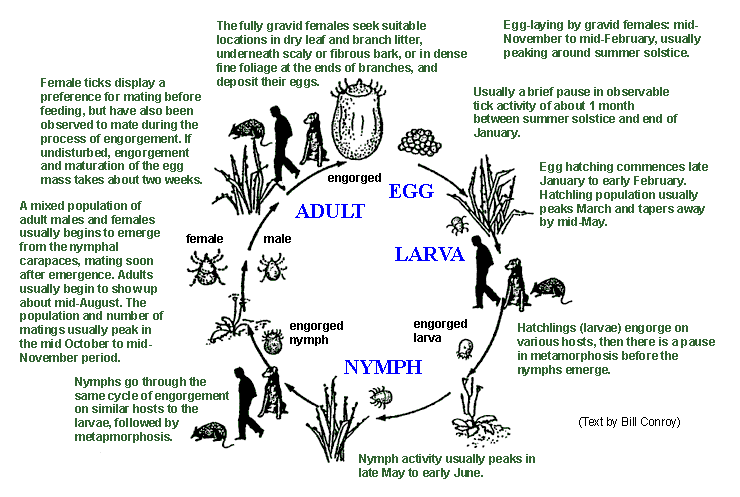|
Ixodes Holocyclus
''Ixodes holocyclus'', commonly known as the Australian paralysis tick, is one of about 75 species in the Australian tick fauna and is considered the most medically important. It can cause paralysis by injecting neurotoxins into its host. It is usually found in a 20-kilometre wide band following the eastern coastline of Australia. Within this range ''Ixodes holocyclus'' is the tick most frequently encountered by humans and their pets. As this area also contains Australia's most densely populated regions, bites on people, pets and livestock are relatively common. Paralysis ticks are found in many types of habitat particularly areas of high rainfall such as wet sclerophyll forest and temperate rainforest. The natural hosts for the paralysis tick include koalas, bandicoots, possums and kangaroos. Common names The use of common names has led to many colloquial expressions for ''Ixodes holocyclus''. The most generally accepted name used within Australia is ''Australian paralysis ti ... [...More Info...] [...Related Items...] OR: [Wikipedia] [Google] [Baidu] |
Australia
Australia, officially the Commonwealth of Australia, is a Sovereign state, sovereign country comprising the mainland of the Australia (continent), Australian continent, the island of Tasmania, and numerous List of islands of Australia, smaller islands. With an area of , Australia is the largest country by area in Oceania and the world's List of countries and dependencies by area, sixth-largest country. Australia is the oldest, flattest, and driest inhabited continent, with the least fertile soils. It is a Megadiverse countries, megadiverse country, and its size gives it a wide variety of landscapes and climates, with Deserts of Australia, deserts in the centre, tropical Forests of Australia, rainforests in the north-east, and List of mountains in Australia, mountain ranges in the south-east. The ancestors of Aboriginal Australians began arriving from south east Asia approximately Early human migrations#Nearby Oceania, 65,000 years ago, during the Last Glacial Period, last i ... [...More Info...] [...Related Items...] OR: [Wikipedia] [Google] [Baidu] |
Lifecycle
Life cycle, life-cycle, or lifecycle may refer to: Science and academia * Biological life cycle, the sequence of life stages that an organism undergoes from birth to reproduction ending with the production of the offspring *Life-cycle hypothesis, in economics * Erikson's stages of psychosocial development, in psychoanalysis Business * Enterprise life cycle, the process of changing a business enterprise *Project life cycle *Product lifecycle, the stages in the lifespan of a commercial or consumer product *New product development, the process of bringing a new product to market * Life-cycle assessment, the analysis of the environmental impacts associated with a product * Technology lifecycle, the commercial gain of a product Software *Software development life cycle *Software release life cycle * Object lifetime of an object in object-oriented programming *Program lifecycle phases are the stages a computer program undergoes, from initial creation to deployment and execution Syst ... [...More Info...] [...Related Items...] OR: [Wikipedia] [Google] [Baidu] |
Alloscutum
A scute or scutum (Latin: ''scutum''; plural: ''scuta'' " shield") is a bony external plate or scale overlaid with horn, as on the shell of a turtle, the skin of crocodilians, and the feet of birds. The term is also used to describe the anterior portion of the mesonotum in insects as well as some arachnids (e.g., the family Ixodidae, the scale ticks). Properties Scutes are similar to scales and serve the same function. Unlike the scales of lizards and snakes, which are formed from the epidermis, scutes are formed in the lower vascular layer of the skin and the epidermal element is only the top surface . Forming in the living dermis, the scutes produce a horny outer layer that is superficially similar to that of scales. Scutes will usually not overlap as snake scales (but see the pangolin). The outer keratin layer is shed piecemeal, and not in one continuous layer of skin as seen in snakes or lizards. The dermal base may contain bone and produce dermal armour. Scutes with a ... [...More Info...] [...Related Items...] OR: [Wikipedia] [Google] [Baidu] |
Ixodes Holocyclus, Adult Female Paralysis Tick, Unengorged, Ventral Aspect
''Ixodes'' is a genus of hard-bodied ticks (family Ixodidae). It includes important disease vectors of animals and humans (tick-borne disease), and some species (notably ''Ixodes holocyclus'') inject toxins that can cause paralysis. Some ticks in this genus may transmit the pathogenic bacterium ''Borrelia burgdorferi'' responsible for causing Lyme disease. Additional organisms that may be transmitted by ''Ixodes'' are parasites from the genus ''Babesia'', which cause babesiosis, and bacteria from the related genus ''Anaplasma'', which cause anaplasmosis. Species These species are recognised within the genus ''Ixodes'': *''Ixodes abrocomae'' Lahille, 1917 *''Ixodes acer'' Apanaskevich & Schenk, 2020 *''Ixodes acuminatus'' Neumann, 1901 *''Ixodes acutitarsus'' (Karsch, 1880) *''Ixodes affinis'' Neumann, 1899 *''Ixodes albignaci'' Uilenberg & Hoogstraal, 1969 *''Ixodes alluaudi'' Neumann, 1913 *'' Ixodes amarali'' Fonseca, 1935 *'' Ixodes amersoni'' Kohls, 1966 *'' Ixodes anat ... [...More Info...] [...Related Items...] OR: [Wikipedia] [Google] [Baidu] |


.jpg)